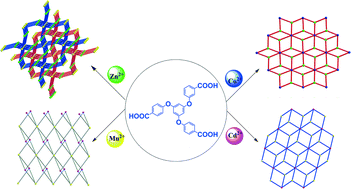Four metal–organic frameworks based on a semirigid tripodal ligand and different secondary building units: structures and electrochemical performance†
Abstract
Four new metal–organic frameworks (MOFs), [Co3(TCPB)2(CH3OH)4]·4DMF (1), [Cd3(TCPB)2(H2O)4]·3DMF·19H2O (2), [Mn3(TCPB)2(H2O)2(DMF)2]·2DMF (3), and [Zn2(μ3-OH) (TCPB)(H2O)(DEF)]·3DEF (4) (H3TCPB = 1,3,5-tri(4-carboxyphenoxy)benzene), have been successfully synthesized and structurally characterized. Structural analyses show that complexes 1–3 present two-dimensional (3,6)-connected kgd net topology with the Schläfli symbol of (43)2(46·66·83) based on linear trinuclear M3(COO)6 (M = Co, Cd, and Mn) secondary building units (SBUs) and display distinct one-dimensional (1-D) channels. Complex 4 (Zn-TCPB) exhibits a rare three-dimensional twofold interpenetrated (3,6)-connected rutile topology with the Schläfli symbol of (42·610·83) (4·62)2 based on the tetranuclear Zn4(μ3-OH)2(COO)6 clusters, which shows three different types of 1-D opening channels. In addition, as an anode material, the complex 4 (Zn-TCPB) electrode exhibits an irreversible high capacity in the first discharge process and a reversible lithium storage capacity of up to about 455 mA h g−1 at 0.1 A g−1 after 100 cycles. This might provide a new method for finding a promising candidate for the electrode materials in lithium-ion batteries.


 Please wait while we load your content...
Please wait while we load your content...